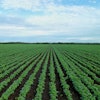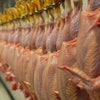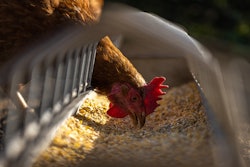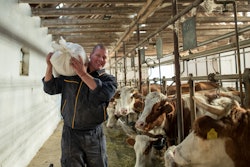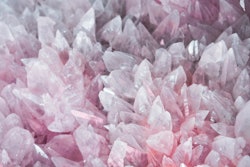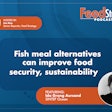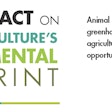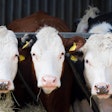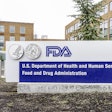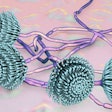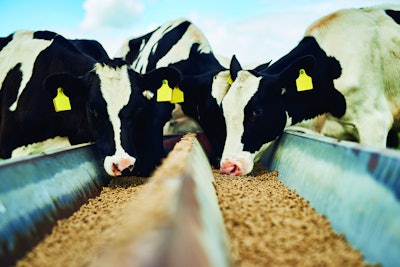
Feed additives that reduce methane emissions from dairy cattle are just one tool in a wide range of methane mitigation strategies available to meet the goal of lowering the carbon footprint of dairy farming.
Methane is a powerful greenhouse gas (GHG), which traps more heat in the atmosphere per molecule than carbon dioxide (CO2), making it 80 times more harmful than CO2for 20 years after it is released, according to theUnited Nations Environment Programme。
In the U.S., 35% of total methane emissions come from all livestock, with 11% coming from dairy cattle, 20% from beef cattle and 4% from pork, according toSelko, the feed additives brand of Trouw Nutrition。
“Within the livestock category, the way that methane is being emitted is not the same,” said Ermias Kebreab, associate dean and professor of animal science atUniversity of California, Davis, during a Selko webinar in May. “For example, in beef cattle, almost all of it is coming from the front end because the manure is deposited in the soil. A lot of beef cattle are on pasture, so the manure will be exposed to air, and for methane to be formed, you need anaerobic conditions. So that’s why a lot of it is coming from the front end. While in the dairy, it’s almost 50-50: you have 57% coming from the front end, or enteric emissions, and manure management also contributes quite significantly because the manure, a lot of it is handled in a lagoon.”
TheGlobal Methane Pledge,由超过150个国家签署的目标cutting anthropogenic methane emissions at least 30% by 2030 from 2020 levels. Feeding strategies that lower enteric methane emissions from dairy cattle are key to meeting this goal.
“Methane mitigation strategies for reducing the carbon footprint of cattle should target enteric methane from cows as well as methane coming from manure,” Selko says on its website. “The target for the future is reducing the carbon footprint of dairy farming by 50% by 2030, after which we should reduce methane emission from cattle by 1% per year.”
Other strategies besides feed additives that aim to reduce the carbon footprint of dairy production include improving feed efficiency, genetic selection and manure management.
Types of methane-reducing feed additives
There is a variety of methane-reducing feed additives on the market, which may be natural or produced by chemical synthesis and have different modes of action, according to Cedric Faure, head of the ruminant department at French animal nutrition and health companyCCPA Group。(Note: As the development of these products is constantly progressing, not all products on the market will be listed here.)
Studies have found feed additives can reduce methane emissions by 2% to 12% per year, Kebreab said. Feed additives, including seaweed, fatty acids, 3-Nitrooxypropanol (3-NOP), oregano, tannins, nitrate, biochar, cinnamon, garlic and saponins, have been shown to reduce emissions in absolute terms, he said.
Chemical additives includeBovaer from DSM-Firmenich, which is a 3-NOP product registered for use as a feed additive in Europe, andSilvair from Cargill’s Provimi brand。介绍在低剂量直接作用于甲烷synthesis in the rumen, while Silvair stimulates a natural process in the rumen, creating ammonia from hydrogen that would otherwise become methane. This ammonia can subsequently be used to produce milk protein, according to Provimi’s website.
A red algae product in development and not yet commercially available can significantly reduce methane, but also significantly lowers feed intake, compromising performance, Faure said. Australia-basedFutureFeedholds the intellectual property for the use of the seaweedAsparagopsisas a livestock feed ingredient. According to theCommonwealth Scientific and Industrial Research Organization(CSIRO), research trials in Australia and the U.S. have shown the FutureFeed additive reduces methane emissions from cattle by more than 80%.
Products based on essential oils may be of natural or synthetic origin and act by partially reducing the rumen flora. The impact of essential oils on methane is variable, Faure said, depending on the product formulation and the diet.
“These flora orientations can be favorable for zootechnical performance,” he said.
Agolin Ruminant from FeedworksUSAis an essential oil-based product certified by the Carbon Trust for methane reduction in ruminants.Mootral Ruminant, based on a combination of garlic and citrus extract and produced in a pellet format, has been shown to significantly reduce methane emissions from cattle.
Faure added tannins are widely used, but their effect on methane is limited at the doses used. However, plant extracts combined with essential oils result in a reduction in methane and an improvement in feed efficiency.
“These products can therefore be profitable on their own, which encourages their development. Another advantage is that they are natural, making it easier for dairies to promote their image to consumers,” Faure said.
Raw materials such as linseed meal and flax-based feed can also reduce methane emissions from cattle.
Do the benefits outweigh the costs?
Chemical additive solutions can add extra cost for the producer but also significantly reduce emissions. Therefore, Faure said, their use “will necessarily require a new economic model: resale on the carbon market or a bonus on the milk price. For the first, the current price does not allow the additive to be profitable; for the second, some dairies are reluctant to use a product derived from chemical synthesis for environmental reasons.”
Natural ingredients are more economical because they can improve performance while also reducing methane emissions, but at a lower level, he said.
Feed additives offer the greatest potential for sector-wide methane reductions and could be feasibly implemented at existing operations, according to Frank Mitloehner, professor and air quality specialist at the University of California, Davis, who spoke at the 2023 DSM World Nutrition Forum.
While regulatory red tape has slowed the process of getting some methane-reducing feed additives to market (see sidebar), Mitloehner predicted, “within the next five years, we will have at least a handful of well-working feed additives that will reduce enteric methane, which is the methane belched out by cattle.”
In his example, assuming 1.7 million dairy cows producing 3 metric tons (MT) of carbon dioxide equivalent (CO2e) per year, reductions range from 255,000 MT of CO2e per year with a feed additive that achieves 10% effectiveness at 50% herd penetration to 2.04 million MT of CO2e reductions per year with a 50% reduction effectiveness at 80% herd penetration.
“While most of you think of methane as a liability, as a problem, I tell you, methane is only a problem if you don’t manage it. Methane can be a solution if you do manage it,” Mitloehner said. “Methane is a problem if we just allow it to go up. If we manage it, it can be part of a climate solution.”


